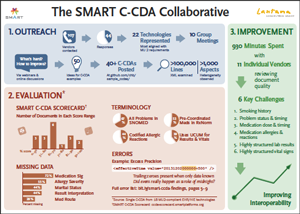This is a quick description of the minimum requirements to turn patient-mediated “transmit” into a usable system for feeding clinical data to a patient’s preferred endpoints. In my blog post last month, I described a small, incremental “trust tweak” asking ONC and CMS to converge on the Blue Button Patient Trust Bundle, so that any patient anywhere has the capability to send data to any app in the bundle.
This proposal builds on that initial tweak. I should be clear that the ideas here aren’t novel: they borrow very clearly from the Blue Button+ Direct implementation guide (which is not part of certification or MU — but aspects of it ought to be).
Continue reading “Certification/MU tweaks to support patient subscriptions”



You must be logged in to post a comment.